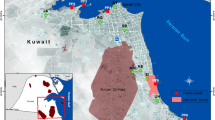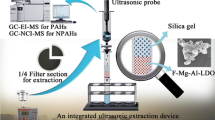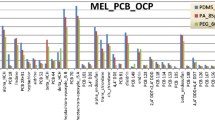Abstract
Persistent organic pollutants (POPs) are globally dispersed substances considered to have adverse effects on health and ecosystems. Organochlorine pesticides (OCPs) are POPs. OCPs can be collected from the air by passive samplers using polyurethane foam (PUF). POPs in PUF are generally extracted by Soxhlet, considered as reference extraction method. We offer a different methodology approach to extract 16 OCPs from the PUF. This technology extracts, filters, collects the sample and evaporates the solvent, without sample transfer. It is a modification of the ultrasound-assisted extraction micro-scale cell (M-UAE-MSC) previously patented by our group. A full factorial experimental design (23 centred) was used to optimise the extraction conditions. The most desirable conditions were 50 °C, 40% ultrasound potency and 20-min extraction time, two extractions. OCP recoveries ranged from 67 to 110%. OCP recoveries were equivalent by M-UAE-MSC and Soxhlet techniques. The method was not suitable for five OCPs, and further refinement is needed. Method linearity (r2) was ≥ 0.98. Limits of detection were observed between 1.2 and 4.6 ng PUF−1, while limits of quantification were found between 3.9 and 15.2 ng PUF−1. The method was applied to determine OCPs collected by PUF passive samplers in Mexico. Endosulfan I was the OCP most frequently observed. The M-UAE-MSC optimised extraction conditions, decreased the extraction time from several hours to less than 1 h and reduced three times the solvent consumption with respect to Soxhlet. This afforded a decrease in the waste generation and a reduction in the OCP-extraction cost up to 80%. The results of this study reveal an efficient and consistent procedure, as well as a simpler, faster, cost-saving and more environmentally friendly method to determine OCPs collected by PUF in passive samplers compared to Soxhlet extraction.



Similar content being viewed by others
References
Alegria, H. A., Wong, F., Jantunen, L. M., Terry, B., Miguel, S. F., Gold-Bouchot, G., et al. (2008). Organochlorine pesticides and PCBs in air of southern Mexico (2002–2004). Atmospheric Environment, 42(38), 8810–8818. https://doi.org/10.1016/j.atmosenv.2008.04.053.
Amador-Muñoz, O., Santos-Medina, G., Jazcilevich, A. & Valle, B. (2014). Celda de extracción a microescala, asistida por ultrasonido, con y sin reflujo, acoplada a un sistema de filtración. IMPI, Patent No. 325624.
Aydin, M. E., Ozcan, S., & Tor, A. (2007). Ultrasonic solvent extraction of persistent organic pollutants from airborne particles. Clean Soil Air Water, 35(6), 660–668. https://doi.org/10.1002/clen.200700049.
Baron, P.A. & Willeke, K. (2001). Aerosol measurement. Principles, techniques and applications. 2nd Ed., Wiley Interscience.
Bergman, A.; Heindel, J.J.; Jobling, S.; Kidd, K.A. & Zoeller, R.T. (2013). State of the science of endocrine disrupting chemicals 2012. Summary of decision makers. WHO and UNEP. http://apps.who.int/iris/bitstream/handle/10665/78102/WHO_HSE_PHE_IHE_2013.1_eng.pdf;jsessionid=F61ABFD4DA5666C899BA5576DA3A7A92?sequence=1. Accessed 10 May 2018.
Beristain-Montiel, E., Villalobos-Pietrini, R., Arias-Loaiza, G. E., Gómez-Arroyo, S. L., & Amador-Muñoz, O. (2016). An innovative ultrasound assisted extraction micro-scale cell combined with gas chromatography/mass spectrometry in negative chemical ionization to determine persistent organic pollutants in air particulate matter. Journal of Chromatography A, 1477, 100–107. https://doi.org/10.1016/j.chroma.2016.11.043.
Briand, O., Bertrand, F., Seux, R., & Millet, M. (2002). Comparison of different sampling techniques for the evaluation of pesticide spray drift in apple orchards. The Science of the Total Environment, 288(3), 199–213. https://doi.org/10.1016/S0048-9697(01)00961-5.
Cliath, M. M., & Spencer, W. F. (1972). Dissipation of pesticides from soil by volatilization of degradation products. I. Lindane and DDT. Environmental Science & Technology, 6(10), 910–914. https://doi.org/10.1021/es60069a010.
Estellano, V. H., Pozo, K., Harner, T., Franken, M., & Zaballa, M. (2008). Altitudinal and seasonal variations of persistent organic pollutants in the Bolivian Andes Mountains. Environmental Science & Technology, 42, 2528–2534. https://doi.org/10.1021/es702754m.
Harner, T., Shoeib, M., Diamond, M. L., Stern, G., & Rosenberg, B. (2004). Using passive air samplers to assess urban-rural trends for persistent organic pollutants. 1. Polychlorinated biphenyls and organochlorine pesticides. Environmental Science & Technology, 38(17), 4474–4483. https://doi.org/10.1021/es040302r.
Kosikowska, M., & Biziuk, M. (2010). Review of the determination of pesticide residues in ambient air. Trends in Analytical Chemistry, 29(9), 1064–1072. https://doi.org/10.1016/j.trac.2010.06.008.
Larsen, A. E., Gaines, S. D., & Deschênes, O. (2017). Agricultural pesticide use and adverse birth outcomes in the San Joaquin Valley of California. Nature Communications, 8, 302. https://doi.org/10.1038/s41467-017-00349-2.
Martínez-Valenzuela, C., Gómez-Arroyo, S., Villalobos-Pietrini, R., Waliszewski, S., Calderón-Segura, M. E., Félix-Gastélum, R., et al. (2009). Genotoxic biomonitoring of agricultural workers exposed to pesticides in the north of Sinaloa State, Mexico. Environment International, 35(8), 1155–1159. https://doi.org/10.1016/j.envint.2009.07.010.
Menichini, E., Iacovella, N., Monfredini, F., & Turrio-Baldassarri, L. (2007). Atmospheric pollution by PAHs, PCDD/Fs and PCBs simultaneously collected at a regional background site in central Italy and at an urban site in Rome. Chemosphere, 69(3), 422–434. https://doi.org/10.1016/j.chemosphere.2007.04.078.
Montone, R. C., Taniguchi, S., Boian, C., & Weber, R. R. (2005). PCBs and chlorinated pesticides (DDTs, HCHs and HCB) in the atmosphere of the southwest Atlantic and Antarctic oceans. Marine Pollution Bulletin, 50(7), 778–786. https://doi.org/10.1016/j.marpolbul.2005.03.002.
Nascimento, M. M., da Rocha, G. O., & de Andrade, J. B. (2017). Pesticides in fine airborne particles: from a green analysis method to atmospheric characterization and risk assessment. Scientific Reports, 7(2267), 1–11. https://doi.org/10.1038/s41598-017-02518-1.
Pankow, J. F. (1989). Overview of the gas phase retention volume behavior of organic compounds on polyurethane foam. Atmospheric Environment, 23(5), 1107–1111. https://doi.org/10.1016/0004-6981(89)90311-9.
Pentamwa, P., & Oanh, N. T. K. (2008). Levels of pesticides and polychlorinated biphenyls in selected homes in the Bangkok Metropolitan Region, Thailand. Annals of the New York Academy of Science, 1140, 91–112. https://doi.org/10.1196/annals.1454.005.
Pozo, K., Harner, T., Shoeib, M., Urrutia, R., Barra, R., Parra, R., et al. (2004). Passive-sampler derived air concentrations of persistent organic pollutants on a north-south transect in Chile. Environmental Science & Technology, 38, 6529–6537. https://doi.org/10.1021/es049065i.
Pozo, K., Harner, T., Wania, F., Muir, D. C. G., Jones, K. C., & Barrie, L. A. (2006). Toward a global network for persistent organic pollutants in air: results from the GAPS study. Environmental Science & Technology, 40, 4867–4873. https://doi.org/10.1021/es060447t.
Pozo, K., Harner, T., Lee, S. C., Wania, F., Muir, D. C. G., & Jones, K. C. (2009). Seasonally resolved concentrations of persistent organic pollutants in the global atmosphere from the first year of the GAPS study. Environmental Science & Technology, 43, 796–803. https://doi.org/10.1021/es802106a.
Pozo, K., Oyola, G., Estellano, V. H., Harner, T., Rudolph, A., Prybilova, P., et al. (2017). Persistent organic pollutants (POPs) in the atmosphere of three Chilean cities using passive air samplers. The Science of the Total Environment, 586, 107–114. https://doi.org/10.1016/j.scitotenv.2016.11.054.
Primbs, T., Genualdi, S., & Simonich, S. M. (2008). Solvent selection for pressurized liquid extraction of polymeric sorbents used in air sampling. Environmental Toxicology and Chemistry, 27(6), 1267–1272. https://doi.org/10.1897/07-566.1.
Sullivan, G.O. & Megson, D. (2014). Brief overview: discovery, regulation, properties, and fate of POPs. In G. O’Sullivan & C. Sandau (Eds.), Environmental forensics for persistent organic pollutants (pp. 1–20). Elsevier B.V.
Tominaga, M. Y., Silva, C. R., Melo, J. P., Niwa, N. A., Plascak, D., Souza, C. A., et al. (2016). PCDD, PCDF, dl-PCB and organochlorine pesticides monitoring in São Paulo City using passive air sampler as part of the global monitoring plan. The Science of the Total Environment, 571, 323–331. https://doi.org/10.1016/j.scitotenv.2016.07.173.
UNEP (2010). Stockholm Convention on persistent organic pollutants (POPs). Text and Anexes as ammended in 2009. http://www.wipo.int/edocs/trtdocs/en/unep-pop/trt_unep_pop_2.pdf. Accessed 10 May 2018.
USEPA (1999). United States Environmental Protection Agency. Compendium of methods for the determination of toxic organic compounds in ambient air. Compendium method TO-10A. Determination of pesticides and polychlorinated biphenyls in ambient air using low volume polyurethane foam (puf) sampling followed by gas chromatographic/multi-detector detection (GC/MD). Second Edition. https://www.epa.gov/sites/production/files/2016-02/documents/to-10ar.pdf. Accessed 10 May 2018.
Wang, H., **a, B., Lu, Y., Ge, Z., & Tang, J. (2016). Experimental study on sonic vibrating effects of cavitation water jets and its promotion effects on coalbed methane desorption. Fuel, 185, 468–477. https://doi.org/10.1016/j.fuel.2016.08.024.
Wong, F., Alegria, H. A., Bidleman, T. F., Alvarado, V., Angeles, F., Ávila-Garza, A., et al. (2009). Passive air sampling of organochlorine pesticides in Mexico. Environmental Science & Technology, 43(3), 704–710. https://doi.org/10.1021/es802385j.
Wurl, O., & Obbard, J. P. (2005). Organochlorine compounds in the marine atmosphere of Singapore. Atmospheric Environment, 39, 7207–7216. https://doi.org/10.1016/j.atmosenv.2005.09.001.
Xu, W., Wang, X., & Cai, Z. (2013). Analytical chemistry of the persistent organic pollutants identified in the Stockholm Convention: a review. Analytica Chimica Acta, 790, 1–13. https://doi.org/10.1016/j.aca.2013.04.026.
Yaduvanshi, S., Srivastava, N., Marotta, F., Jain, S., & Yadav, H. (2012). Evaluation of micronuclei induction capacity and mutagenicity of organochlorine and organophosphate pesticides. Drug Metabolism Letters, 6(3), 187–197. https://doi.org/10.2174/1872312811206030006.
Yang, Y., Li, D., & Mu, D. (2008). Levels, seasonal variations and sources of organochlorine pesticides in ambient air of Guangzhou, China. Atmospheric Environment, 42, 677–687. https://doi.org/10.1016/j.atmosenv.2007.09.061.
Yusà, V., Coscollà, C., Mellouki, W., Pastor, A., & de la Guardia, M. (2009). Sampling and analysis of pesticides in ambient air. Journal of Chromatography A, 1216, 2972–2983. https://doi.org/10.1016/j.chroma.2009.02.019.
Acknowledgements
GEAL acknowledges CONACyT for PhD scholarship research number 258102. The authors thank Araceli Peña-Álvarez and Violeta Mugica-Álvarez for their valuable comments. We also acknowledge Abraham Lara, Wilfrido Gutiérrez, Manuel García, Bárbara Cuesta, Alfredo Rodriguez, Claudio Amezcua and Saúl Armendariz for their technical support. We thank PRS and Diego Alfaro for the review of the English language.
Funding
This study was financially supported by projects PAPIIT-UNAM (IN116614), Programa Bilateral Mexico-Argentina CONACyT-MINCyT (191335), Red Temática de Toxicología de Plaguicidas (280045) and RUOA-UNAM.
Author information
Authors and Affiliations
Corresponding author
Electronic supplementary material
ESM 1
(DOCX 87 kb)
Rights and permissions
About this article
Cite this article
Arias-Loaiza, G.E., Beristain-Montiel, E., Gómez-Arroyo, S. et al. A Thermo-Cavitation Method to Determine Organochlorine Pesticides in Gas and Particle Phases Collected in Polyurethane Foam Used in Passive Air Samplers. Water Air Soil Pollut 229, 282 (2018). https://doi.org/10.1007/s11270-018-3941-8
Received:
Accepted:
Published:
DOI: https://doi.org/10.1007/s11270-018-3941-8




